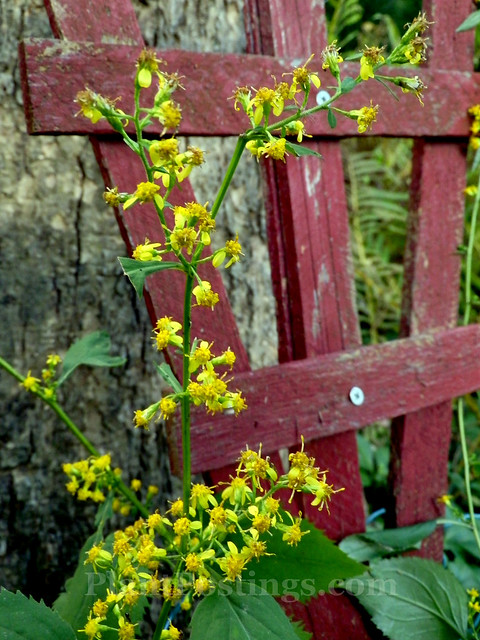
Goldenrods (Solidago spp.) are among the best nectar sources for supporting late-season native bees and migrating butterflies like the Monarch, according to The Xerces Society for Invertebrate Conservation.
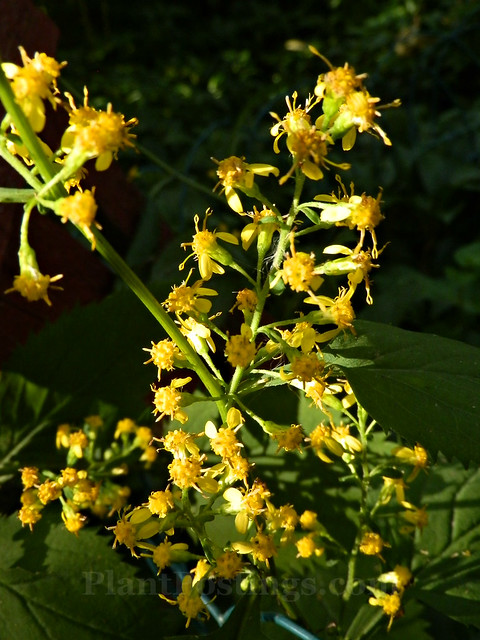
If you have a shady garden as I do, the choices within this genus are somewhat limited. But one of the Goldenrods that performs well in partial shade, and even in heavy shade, is Zigzag Goldenrod (Solidago flexicaulis), also known by the nickname Broadleaf Goldenrod. It also tolerates sunny locations. It's a sweet little bloomer in addition to helping the pollinators.
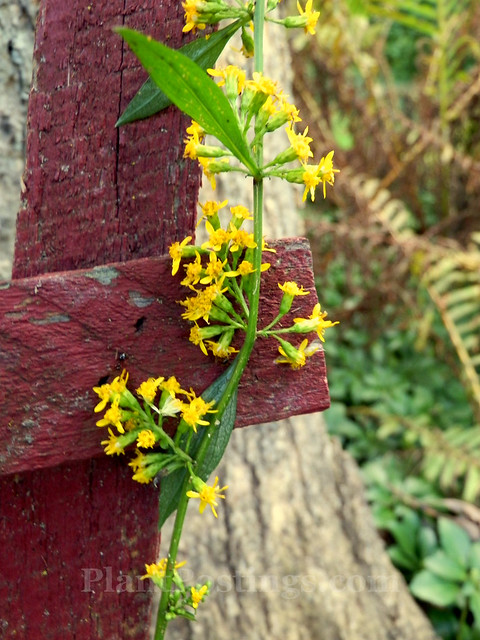
Just as the Coneflowers, Joe Pyes, and other summer bloomers fade, Zigzag Goldenrod shares its bright, yellow flowers. My patch is blooming against a trellis, filling in an area where Foxglove was the focal point during the early summer.
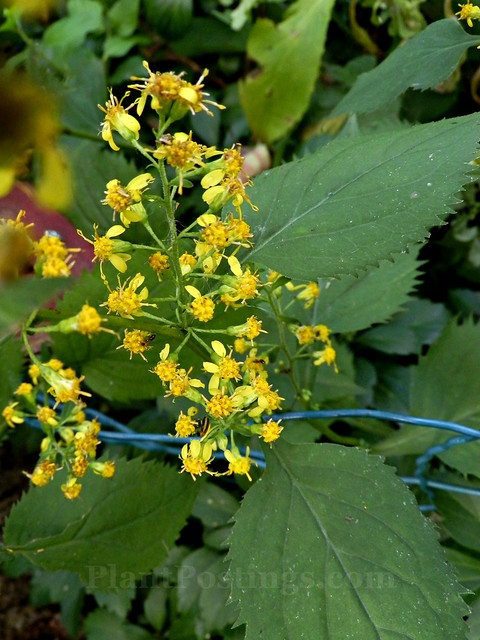
Zigzag Goldenrod is native to most of Eastern North America, according to the Missouri Botanical Garden. It prefers moist, woodland soils, but when established will tolerate some drought. Other plant characteristics include:
- Height and spread: 1 ft. to 4 ft.;
- USDA hardiness zones 3 to 8;
- Propagates by self-seeding and rhizomes;
- Prefers medium moisture and soil, but tolerates a range of soils and precipitation; and
- Distinguished by zigzag stems and toothed, broad leaves.
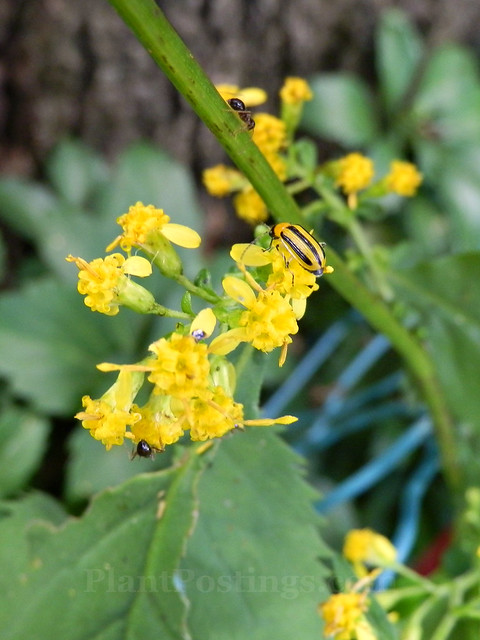
On the day I took most of these photos the wind was strong, so the bees weren't landing much. But I did see quite a few insects on the plants--spiders, ants, and beetles of various types.

I think this is a Striped Cucumber Beetle--not a friend of the vegetable gardener. Fortunately, no veggies are located in this part of the garden, and the beetles didn't appear to be damaging the flowers. Maybe that's a good technique--plant the Goldenrod outside the vegetable garden to attract the beetles away from your edibles. Just a thought?

I also like the appearance when the flowers begin to fade--the seedheads are fluffy and attractive.

Zigzag Goldenrod has been in my garden for only a few years, but it's earned my admiration and respect for its beauty and functionality in the autumn landscape.
(I'm linking this post to Wildflower Wednesday.)
The Zigzag Solidago was new to me until I saw it earlier this morning on Gardeninacity blog. I bought Solidao rugosa specially, as I heard it is so important for bees in late summer. It is pretty too.
ReplyDeleteYes, Jason has an amazing patch of it! I hope mine will fill in like that! I enjoy the Goldenrods, always have. With a shady lot, however, this is my best choice. :)
DeleteI am looking for some plants for our woodland garden since the voles ate so much of what we had planted there. This looks like it will fit the bill and I love that it supports late season pollinators. Thanks for the recommendation Beth!
ReplyDeleteYes, this is a great option for your woodland! I might recommend protecting it for the first few years with lava rock at the base and chicken-wire fencing. Mine has taken a few years to establish--I think because of rabbits eating it, and voles, chipmunks, and squirrels digging it up. But now that it's establishing, it's filling in nicely. :)
DeleteGoldenrod of every sort is looking smashing this time of year. I love the zig and the zag.
ReplyDeleteI agree: I've always loved the Goldenrods! And they're also great cut flowers, which I forgot to mention (probably because I don't have enough of it yet to cut!). Yes, the form of this one is fun.
DeleteI've never planted Zig-zag goldenrod because I have so many volunteers of the other, taller kinds. But I've seen it in many gardens, and I really like its shape compared to most species. It's also better behaved than many of the others, I believe. Great shots of the insects on the goldenrod!
ReplyDeleteThanks, Rose. I wish I had more Goldenrods! You are fortunate! Growing them in the shade is challenging. If I had more sun, I would also plant S. speciosa and S. rugosa 'Fireworks' (my favorite of all!)
DeleteI have it, too, and it performs well in a particularly tough, dry shade spot in my garden that gets only the brightest, harsh noonday sunlight. The pollinators love it.
ReplyDeleteHi Helen: That sounds like the perfect spot for it! It's relatively new to my garden and is taking a little time to establish (probably because of critters eating it and digging it up), but now I'm seeing progress and I want to plant more of it!
DeleteThere's a great variegated version as well that offers some yellow splashes of color in the foliage when not in bloom. I use it in the shaded garden with Hostas, ferns, and Heuchera. Really a great plant.
ReplyDeleteHi Nick: I'll have to check on that one. It sounds beautiful!
DeleteI profiled it last year and have a few pics up.
Deletehttp://www.confessionsofaplantgeek.com/2015/03/variegated-zig-zag-goldenrod-solidago.html
I'd like to try this in shade! (I don't think it would survive or appreciate Tennessee full sun.)
ReplyDeleteAs Chloris mentions above, you and Jason at GardeninaCity featured this both on the same day! https://gardeninacity.wordpress.com/2016/09/28/zigzag-goldenrod-the-lovable-thug/
Yes--great minds think alike. ;-) I'm sure it would work well in the shade for you. Gail at Clay and Limestone has it in shade in her Tennessee garden. It's native to your area.
DeleteI have a variegated variety although the variegation is very slight. It's in a dry shady spot and thriving. Hooray!
ReplyDeleteNice! The sources on this one vary in their recommendations for its moisture and soil types. Sounds like it can handle (or actually thrives) in a variety of settings! Cheers!
Deletethat unusual form, with angles, makes a refreshing change
ReplyDeleteYes, it really lives up to its zigzag name. :)
DeleteI love your photos! Your zig zag is more upright than mine, which tend to sprawl a bit. Your leaves look healthier, too. I think mine have a disease of some kind on the leaves. Still, it's fun to see insects on them. For some reason, I didn't see any insects on mine when I was taking photos for my post, so didn't include it.
ReplyDeleteHi Sue: My patch isn't very large yet, and to be honest, I kind of propped it up against the trellis a little. Some of the branches got clipped, but new flowers formed on them anyway. But the tall ones were kind of sprawling a little, which is fine with me--makes for an interesting form. I was surprised to find the cucumber beetles on it.
DeleteOh, and I don't remember if the rabbits here have eaten the zig zag goldenrod here. I have lots of other things they like. Also, they seem to have different favorites from year to year. This year, it was the asters, liatris, and purple prairie clover.
ReplyDeleteYes, I know what you mean about the rabbits' tastes changing from year to year. They always munch on the Hostas, but we have so many. But last year, the rabbits were voracious for every new plant I put in the garden ... except for the ones that were toxic to them.
DeleteSo funny that you and Jason had the same idea...within hours of each other! I am amazed at how many pollinators goldenrod attracts - I only have the common "weed" at the edge of the wooded area but I had never noticed until just this year how much the pollinators love it. It was just teaming with life. I normally pull it out, hoping to eradicate it, but I'm having a change of heart. It pops up everywhere so I'll still remove those that show up in the flower beds, but I'll make sure to leave some in the wooded area for all my tiny friends to enjoy.
ReplyDeleteYes, great minds think alike! Do you have the Canada Goldenrod (Solidago canadensis)? We have a lot of that here, too--along the roadsides and at the arboretum and other places. It's beautiful, but I know it can be dominant in our type of climate. I like your strategy of pulling some and leaving some for the pollinators. :)
DeleteWell, I had to look that up (of course!) but it does indeed look exactly like that, so I'm assuming that's what it is. And like you, it does grow on roadsides, etc., which makes me quite happy when I think of all those millions of happy little pollinators that are feasting on them :)
DeleteNever heard of this one but it looks terrific. Who knew there was a goldenrod that would tolerate shade!
ReplyDeleteIt's starting to fill in. It's not as dramatic as some of the other Goldenrods, but I suppose when the patch gets larger it will have more impact. I really like it, though. :)
DeleteBeautiful!
ReplyDeleteIt is a pretty plant, isn't it? :)
DeleteNeat! So different from the goldenrods I know--in leaves, inflorescence, habitat
ReplyDeleteYes, very different. I doubt the others would grow or survive in my shady garden, so it's nice to have this option.
DeleteNice close up photographs! So funny that we both had the same goldenrod species on our minds at the same time.
ReplyDeleteThanks, Jason. Yes, great minds think alike! I'm envious of your large patch of this plant! I wonder if mine will ever approach that size? So, my patch is difficult to see from a distance ... hence, the close shots. LOL.
DeleteGreat shots and I can see why it's become a fall favorite.
ReplyDeleteThanks, Tina. Yes, I hope I can get it to establish in other parts of the garden.
DeleteI have this planted along the pond... love my goldenrods... Michelle
ReplyDeleteOh, that sounds like the perfect place for them. I'm hoping to add more in several spots around the garden. :)
DeleteGoldenrods grow wild all around my garden and out by our detention pond, though I think most of them are sun-loving ones. Definitely a pollinator favorite! It's nice that there is one that tolerates some shade, too.
ReplyDeleteLucky you! If I ever have a sunny garden again, more Goldenrods will definitely be a part of it!
DeleteLoved your Goldenrod photos . . .
ReplyDeleteAnd the bees, beetles and other insects.
Goldenrod was one plant I was taught to stay away from at a very early age. My brother would get very, very ill every time it would come in bloom, late August, September. Often to the point of hospitalization . . . I enjoy seeing it but not the memories that have gone with it.
Thanks, Lynne. Goldenrod is very unlikely to have been the cause of your brother's illness/allergy. It's largely a myth that perpetuated for generations. Most people who think they're allergic to Goldenrod are actually allergic to Ragweed and other plants that bloom at the same time: http://blog.nwf.org/2014/09/the-goldenrod-allergy-myth/. I can certainly understand the negative memories, but hopefully folks moving forward will realize it's likely other plants that are causing the problem. Goldenrod is so beneficial to pollinators and unlikely to cause problems for humans.
DeleteI love Goldenrod. When my husband and I first started dating, it was at the end of July. He knew of my love of Goldenrod. He picked me a huge bouquet.
ReplyDeleteYes, I have some in two of my gardens.
Awww, what a sweet story and a sweet husband! I really enjoy using Goldenrod in bouquets. Most of the species have a long vase life, and the blooms are so cheery!
DeleteLovely photos! I like the combination of the goldenrod with the red trellis.
ReplyDeleteThank you, Deb. I hope it will fill in and bulk up a little more to make a statement. ;-)
Deletei like the Goldenrod and its handy to know that it tolerates shade, however what about that Striped Cucumber Beetle, never seen the likes.
ReplyDeleteYes, it's an interesting little beetle, isn't it? I remember seeing the beetles in my large veggie garden when I had a sunny property. I haven't noticed them here in the shade until I planted the Goldenrod.
DeleteNice photos. So sad that some of the goldenrod and asters are already dying off.
ReplyDeleteThanks, Heather. Yeah, it seems like the Goldenrods didn't like all the rain and got mushy fast. I am still noticing plentiful Asters blooming, though. And my Blue Mistflowers are still going strong--probably until the first frost. Hope that doesn't happen for a while. ;-)
DeleteThis looks like an interesting. I've been working in a town park garden that is focusing on native plants and plants for pollinators. There is quite a lot of goldenrod, but my concern is that visitors to the garden only see 'weeds". We are trying to educate them.
ReplyDelete